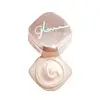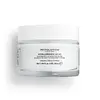What's inside
What's inside
 Key Ingredients
Key Ingredients

 Benefits
Benefits

 Concerns
Concerns

 Ingredients Side-by-side
Ingredients Side-by-side

Rosa Damascena Flower Water
MaskingButylene Glycol
HumectantHydrogenated Poly(C6-14 Olefin)
EmollientSqualane
EmollientGlycerin
HumectantCaprylic/Capric/Myristic/Stearic Triglyceride
EmollientButyrospermum Parkii Butter
Skin ConditioningCetearyl Alcohol
EmollientNiacinamide
SmoothingMacadamia Integrifolia Seed Oil
Skin ConditioningGlyceryl Stearate
EmollientPhytosteryl/Isostearyl/Cetyl/Stearyl/Behenyl Dimer Dilinoleate
Skin ConditioningCyclopentasiloxane
EmollientSynthetic Beeswax
Emulsion StabilisingPEG-40 Stearate
EmulsifyingCeramide AP
Skin Conditioning1,2-Hexanediol
Skin ConditioningWater
Skin ConditioningCyclohexasiloxane
EmollientPEG-100 Stearate
Caprylic/Capric Triglyceride
MaskingDimethicone
EmollientPEG-30 Dipolyhydroxystearate
EmulsifyingCaprylyl Glycol
EmollientPolyacrylamide
C13-14 Isoparaffin
EmollientNelumbo Nucifera Flower Extract
Skin ConditioningPrunus Mume Fruit Extract
HumectantSodium Polyacrylate
AbsorbentCopernicia Cerifera Wax
Tocopheryl Acetate
AntioxidantCitrus Aurantium Dulcis Peel Oil
MaskingCitrus Nobilis Peel Oil
MaskingEthylhexyl Cocoate
EmollientEthylhexylglycerin
Skin ConditioningPolyglyceryl-6 Stearate
EmollientDisodium EDTA
Laureth-7
EmulsifyingEclipta Prostrata Extract
Skin ConditioningHippophae Rhamnoides Oil
EmollientPPG-3 Benzyl Ether Myristate
EmollientCananga Odorata Flower Oil
MaskingCitrus Aurantium Amara Peel Oil
Skin ConditioningHydrolyzed Hibiscus Esculentus Extract
Skin ConditioningLupinus Albus Seed Extract
Skin ConditioningMoringa Oleifera Seed Extract
Skin ConditioningCitrus Reticulata Leaf Oil
MaskingPolysorbate 20
EmulsifyingMelia Azadirachta Leaf Extract
Skin ConditioningPolyglyceryl-6 Behenate
Emulsion StabilisingHelianthus Annuus Seed Oil Unsaponifiables
EmollientSimmondsia Chinensis Seed Oil
EmollientSodium Hyaluronate
HumectantMoringa Oleifera Seed Oil
EmollientTocopherol
AntioxidantXylitylglucoside
HumectantAnhydroxylitol
HumectantXylitol
HumectantHydrogenated Lecithin
EmulsifyingGlucose
HumectantGlycine
BufferingSerine
MaskingGlutamic Acid
HumectantCeramide NP
Skin ConditioningHydrolyzed Collagen
EmollientAspartic Acid
MaskingLeucine
Skin ConditioningAlanine
MaskingLysine
Skin ConditioningArginine
MaskingTyrosine
MaskingPhenylalanine
MaskingProline
Skin ConditioningThreonine
Valine
MaskingIsoleucine
Skin ConditioningHistidine
HumectantCysteine
AntioxidantMethionine
Skin ConditioningRosa Damascena Flower Water, Butylene Glycol, Hydrogenated Poly(C6-14 Olefin), Squalane, Glycerin, Caprylic/Capric/Myristic/Stearic Triglyceride, Butyrospermum Parkii Butter, Cetearyl Alcohol, Niacinamide, Macadamia Integrifolia Seed Oil, Glyceryl Stearate, Phytosteryl/Isostearyl/Cetyl/Stearyl/Behenyl Dimer Dilinoleate, Cyclopentasiloxane, Synthetic Beeswax, PEG-40 Stearate, Ceramide AP, 1,2-Hexanediol, Water, Cyclohexasiloxane, PEG-100 Stearate, Caprylic/Capric Triglyceride, Dimethicone, PEG-30 Dipolyhydroxystearate, Caprylyl Glycol, Polyacrylamide, C13-14 Isoparaffin, Nelumbo Nucifera Flower Extract, Prunus Mume Fruit Extract, Sodium Polyacrylate, Copernicia Cerifera Wax, Tocopheryl Acetate, Citrus Aurantium Dulcis Peel Oil, Citrus Nobilis Peel Oil, Ethylhexyl Cocoate, Ethylhexylglycerin, Polyglyceryl-6 Stearate, Disodium EDTA, Laureth-7, Eclipta Prostrata Extract, Hippophae Rhamnoides Oil, PPG-3 Benzyl Ether Myristate, Cananga Odorata Flower Oil, Citrus Aurantium Amara Peel Oil, Hydrolyzed Hibiscus Esculentus Extract, Lupinus Albus Seed Extract, Moringa Oleifera Seed Extract, Citrus Reticulata Leaf Oil, Polysorbate 20, Melia Azadirachta Leaf Extract, Polyglyceryl-6 Behenate, Helianthus Annuus Seed Oil Unsaponifiables, Simmondsia Chinensis Seed Oil, Sodium Hyaluronate, Moringa Oleifera Seed Oil, Tocopherol, Xylitylglucoside, Anhydroxylitol, Xylitol, Hydrogenated Lecithin, Glucose, Glycine, Serine, Glutamic Acid, Ceramide NP, Hydrolyzed Collagen, Aspartic Acid, Leucine, Alanine, Lysine, Arginine, Tyrosine, Phenylalanine, Proline, Threonine, Valine, Isoleucine, Histidine, Cysteine, Methionine
Water
Skin ConditioningGlycerin
HumectantPropylene Glycol
HumectantCetyl Alcohol
EmollientDimethicone
EmollientPrunus Amygdalus Dulcis Oil
Skin ConditioningSorbitan Stearate
EmulsifyingPentaerythrityl Tetraisostearate
EmollientGlyceryl Stearate
EmollientPEG-100 Stearate
Phenoxyethanol
PreservativePolyacrylamide
C13-14 Isoparaffin
EmollientEthylhexylglycerin
Skin ConditioningSodium Hyaluronate
HumectantTocopheryl Acetate
AntioxidantLaureth-7
EmulsifyingAloe Barbadensis Leaf Juice Powder
Skin ConditioningDisodium EDTA
Sodium Hydroxide
BufferingWater, Glycerin, Propylene Glycol, Cetyl Alcohol, Dimethicone, Prunus Amygdalus Dulcis Oil, Sorbitan Stearate, Pentaerythrityl Tetraisostearate, Glyceryl Stearate, PEG-100 Stearate, Phenoxyethanol, Polyacrylamide, C13-14 Isoparaffin, Ethylhexylglycerin, Sodium Hyaluronate, Tocopheryl Acetate, Laureth-7, Aloe Barbadensis Leaf Juice Powder, Disodium EDTA, Sodium Hydroxide
 Reviews
Reviews

Ingredients Explained
These ingredients are found in both products.
Ingredients higher up in an ingredient list are typically present in a larger amount.
This ingredient is also known as "C13-14 Isoalkane".
C13-14 Isoparaffin is created from petroleum-based mineral oils. It is an emollient and helps thicken a product.
As an emollient, it helps keep the skin soft and smooth by creating a barrier on top. This barrier traps moisture in, keeping the skin hydrated.
C13-14 Isoparaffin may not be fungal-acne safe.
Learn more about C13-14 IsoparaffinDimethicone is a type of synthetic silicone created from natural materials such as quartz.
What it does:
Dimethicone comes in different viscosities:
Depending on the viscosity, dimethicone has different properties.
Ingredients lists don't always show which type is used, so we recommend reaching out to the brand if you have questions about the viscosity.
This ingredient is unlikely to cause irritation because it does not get absorbed into skin. However, people with silicone allergies should be careful about using this ingredient.
Note: Dimethicone may contribute to pilling. This is because it is not oil or water soluble, so pilling may occur when layered with products. When mixed with heavy oils in a formula, the outcome is also quite greasy.
Learn more about DimethiconeDisodium EDTA plays a role in making products more stable by aiding other preservatives.
It is a chelating agent, meaning it neutralizes metal ions that may be found in a product.
Disodium EDTA is a salt of edetic acid and is found to be safe in cosmetic ingredients.
Learn more about Disodium EDTAEthylhexylglycerin (we can't pronounce this either) is commonly used as a preservative and skin softener. It is derived from glyceryl.
You might see Ethylhexylglycerin often paired with other preservatives such as phenoxyethanol. Ethylhexylglycerin has been found to increase the effectiveness of these other preservatives.
Glycerin is already naturally found in your skin. It helps moisturize and protect your skin.
A study from 2016 found glycerin to be more effective as a humectant than AHAs and hyaluronic acid.
As a humectant, it helps the skin stay hydrated by pulling moisture to your skin. The low molecular weight of glycerin allows it to pull moisture into the deeper layers of your skin.
Hydrated skin improves your skin barrier; Your skin barrier helps protect against irritants and bacteria.
Glycerin has also been found to have antimicrobial and antiviral properties. Due to these properties, glycerin is often used in wound and burn treatments.
In cosmetics, glycerin is usually derived from plants such as soybean or palm. However, it can also be sourced from animals, such as tallow or animal fat.
This ingredient is organic, colorless, odorless, and non-toxic.
Glycerin is the name for this ingredient in American English. British English uses Glycerol/Glycerine.
Learn more about GlycerinGlyceryl Stearate is a mix of glycerin and stearic acid.
It is used to stabilize the mixing of water and oil ingredients. By preventing these ingredients from separating, it can help elongate shelf life. It can also help thicken the product's texture.
As an emollient, it helps soften skin and supports barrier-replenishing ingredients.
In cosmetics, Glyceryl Stearate is often made from vegetable oils or synthetically produced.
This ingredient may not be fungal-acne safe
Fun fact: The human body also creates Glyceryl Stearate naturally.
Learn more about Glyceryl StearateLaureth-7 is created by the ethoxylation of lauryl alcohol using ethylene oxide. Lauryl alcohol is a fatty alcohol with hydrating properties.
This ingredient is an emulsifier and cleansing ingredient. As an emulsifier, it is used to prevent ingredients from separating. It also helps cleanse the skin by gathering dirt, oil, and pollutants to be rinsed away.
Peg-100 Stearate is an emollient and emulsifier. As an emollient, it helps keep skin soft by trapping moisture in. On the other hand, emulsifiers help prevent oil and water from separating in a product.
PEGS are a hydrophilic polyether compound . There are 100 ethylene oxide monomers in Peg-100 Stearate. Peg-100 Stearate is polyethylene glycol ester of stearic acid.
Polyacrylamide is a synthetic polymer. It is used to stabilize products and bind ingredients. When hydrated, Polyacrylamide forms a soft gel.
Polyacrylamide is low-toxicity. If source properly, it is deemed safe to use in cosmetics.
It should be noted the precursor to Polyacrylamide is acrylamide. Acrylamide is a carcinogen. Most reputable sources of Polyacrylamide will screen for residual acrylamide to make sure the count is in a safe range. Acrylamide is not able to be absorbed through the skin.
We recommend speaking with a professional if you have concerns.
Learn more about PolyacrylamideSodium Hyaluronate is hyaluronic acid's salt form. It is commonly derived from the sodium salt of hyaluronic acid.
Like hyaluronic acid, it is great at holding water and acts as a humectant. This makes it a great skin hydrating ingredient.
Sodium Hyaluronate is naturally occurring in our bodies and is mostly found in eye fluid and joints.
These are some other common types of Hyaluronic Acid:
Learn more about Sodium HyaluronateTocopheryl Acetate is AKA Vitamin E. It is an antioxidant and protects your skin from free radicals. Free radicals damage the skin by breaking down collagen.
One study found using Tocopheryl Acetate with Vitamin C decreased the number of sunburned cells.
Tocopheryl Acetate is commonly found in both skincare and dietary supplements.
Learn more about Tocopheryl AcetateWater. It's the most common cosmetic ingredient of all. You'll usually see it at the top of ingredient lists, meaning that it makes up the largest part of the product.
So why is it so popular? Water most often acts as a solvent - this means that it helps dissolve other ingredients into the formulation.
You'll also recognize water as that liquid we all need to stay alive. If you see this, drink a glass of water. Stay hydrated!
Learn more about Water